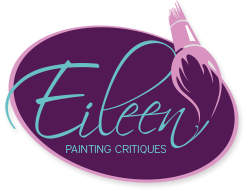Eileen does workshops and demonstrations, including critiques, and teaches art in most mediums:
- Drawing
- Watercolor
- Oil
- Acrylic
- Pen & Ink
- Charcoal
- Mixed Media
- Pottery
- Sculpture
- Wood Carving
- Found Objects
- Jewelry
- Fiber and fabric arts, (Quilts and Wall Art)
- Repurposing furniture and home décor
- Materials including canvas stretching and framing
Painting lessons
Public
Eileen is available to teach, perform critiques, demonstrate or do workshops for individuals, art groups and associations, public and private school systems, home school associations and corporations.
Various rates apply, plus travel time and expenses.
Private
Eileen teaches art and performs critiques in her home in Lake Royale, which is about 30 minutes north, northeast from Raleigh, NC, the capitol city. Lake Royale is almost directly between Wake Forest and Spring Hope, NC and is two miles north of Bunn, NC. She will travel to private homes to give lessons.
Please contact the artist for rates as travel time and expense is considered for both teacher and the student traveling extended distances.
Syllabus
Watercolor Lessons Syllabus
Materials
Brushes
Paper
Paint
Other tools
Basics:
- Two Sponges
- Watercolor goes from light to dark while oil goes from dark to light
- Drawing is not about drawing, it’s about seeing
- Less is more
- Let the brain finish what the eye sees
- Composition
- Planning is 90% of a piece of artwork
- Harmony, Discord and Dominance
- Creating Form Using:
- Shadows
- Light
- Negative Space
- Line
- Shapes
- Values
- Color
- Lost edges
- Creating Distance
- Moving the eye around the painting
- Knowing when to stop
- The “10 foot rule”
Acrylic Lessons Syllabus
Materials
Brushes
Canvas, paper or other support
Paint
Other tools
Basics:
- Timing your paints drying time
- Acrylics dry darker than when wet
- Drawing is not about drawing, it’s about seeing
- Less is more
- Let the brain finish what the eye sees
- Composition
- Planning is 90% of a piece of artwork
- Harmony, Discord and Dominance
- Creating Form Using:
- Shadows
- Light
- Negative Space
- Line
- Line
- Shapes
- Values
- Color
- Lost edges
- Creating Distance
- Moving the eye around the painting
- Knowing when to stop
- The “10 foot rule”
Oil Lessons Syllabus
Materials
Brushes
Canvas, Paper and other supports
Paint
Other tools
Basics:
- Additives and Thinners
- Oil goes from dark to light while Watercolor goes from light to dark
- Drawing is not about drawing, it’s about seeing
- Less is more
- Let the brain finish what the eye sees
- Composition
- Planning is 90% of a piece of artwork
- Harmony, Discord and Dominance
- Creating Form Using:
- Shadows
- Light
- Negative Space
- Line
- Line
- Shapes
- Values
- Color
- Lost edges
- Creating Distance
- Moving the eye around the painting
- Knowing when to stop
- The “10 foot rule”
Pastel Lessons Syllabus
Materials
Brushes
Paper
Various Pastels in different forms
Other tools
Basics:
- Colors on their own
- Blending colors
- Using the right background color
- Drawing is not about drawing, it’s about seeing
- Less is more
- Let the brain finish what the eye sees
- Composition
- Planning is 90% of a piece of artwork
- Harmony, Discord and Dominance
- Creating Form Using:
- Shadows
- Light
- Negative Space
- Line
- Line
- Shapes
- Values
- Color
- Lost edges
- Creating Distance
- Moving the eye around the painting
- Knowing when to stop
- The “10 foot rule”
- Sealing your finished Pastel
Pen & Ink Lessons Syllabus
Materials
Brushes
Paper
Pens
Pencils
Erasers
Other tools
Basics:
- Two Sponges
- Watercolor goes from light to dark while oil goes from dark to light
- Drawing is not about drawing, it’s about seeing
- Less is more
- Let the brain finish what the eye sees
- Composition
- Planning is 90% of a piece of artwork
- Harmony, Discord and Dominance
- Creating Form Using:
- Shadows
- Light
- Negative Space
- Line
- Line
- Shapes
- Values
- Color
- Lost edges
- Creating Distance
- Moving the eye around the painting
- Knowing when to stop
- The “10 foot rule”
Mixed Media Lessons Syllabus
Materials
Brushes
Paper, canvas and other supports
Paint and other varied materials
Other tools
Basics:
- Two Sponges
- Watercolor goes from light to dark while oil goes from dark to light
- Drawing is not about drawing, it’s about seeing
- Less is more
- Let the brain finish what the eye sees
- Composition
- Planning is 90% of a piece of artwork
- Harmony, Discord and Dominance
- Creating Form Using:
- Shadows
- Light
- Negative Space
- Line
- Line
- Shapes
- Values
- Color
- Lost edges
- Creating Distance
- Moving the eye around the painting
- Knowing when to stop
- The “10 foot rule”
Drawing Lessons Syllabus
- Materials
- Pencils, pens and charcoal
- Paper
- Drawing with paint
- Other tools
- Basics:
- Using the right paper or other support
- Using the right value instrument
- Hatching, crosshatching and other drawing techniques
- Drawing is not about drawing, it’s about seeing
- Less is more
- Let the brain finish what the eye sees
- Composition
- Planning is 90% of a piece of artwork
- Harmony, Discord and Dominance
- Creating Form Using:
- Shadows
- Light
- Negative Space
- Line
- Line
- Shapes
- Values
- Color and colored pencils
- Lost edges
- Creating Distance
- Moving the eye around the drawing
- Knowing when to stop
- The “10 foot rule”
